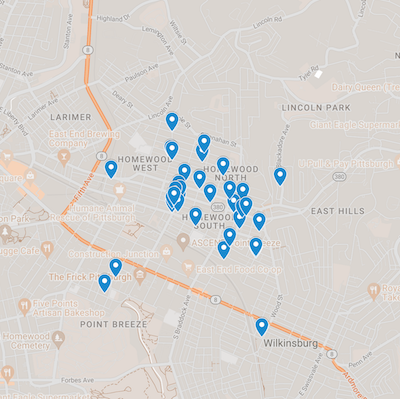
Homewood and Brushton are neighboring sections in the eastern part of Pittsburgh, comprising the present neighborhoods of Homewood North, Homewood South, and Homewood West. Homewood was annexed into the city of Pittsburgh in 1868 and Brushton was added in 1894. The Homewood-Brushton district was largely rural until the early 1870s, when some of the larger estates in the area began to be subdivided. The area north of the railroad became a neighborhood, while land south of the railroad maintained several large estates. With the introduction of an interurban trolley line through the neighborhood in the early 1890s, the population of Homewood-Brushton grew.[1]“An atlas of the Homewood-Brushton neighborhood of Pittsburgh 1977,” University of Pittsburgh Archives and Special Collection (online—Historic Pittsburgh).
A small population of Jewish merchants settled in Homewood and Brushton in the late 19th and early 20th centuries. The early decades of Jewish communal activity in the neighborhood are poorly sourced. According to one second-hand account from 1942, the few Jewish families living in the neighborhood affiliated with the new B’nai Israel Congregation in East Liberty until around 1907, when High Holiday services were held in Homewood for the first time. According to this account, the group subsequently met at various rented spaces throughout the neighborhood, including the Homewood Bank Building and the Homewood branch of the Carnegie Library of Pittsburgh.[2]Arnfield, Ruth. “A Half Century of Faith,” Jewish Criterion, Sept. 11, 1942 (online). The earliest known primary source documentation of Jewish communal worship in Homewood is a 1909 notice announcing High Holiday services at Taylor Hall.[3]“Homewood Congregation,” Jewish Criterion, Sept. 10, 1909 (online).
The Jewish community of Homewood became increasingly organized in 1921 when Jewish people living in Homewood, Brushton, and Wilkinsburg undertook several major initiatives. Within the first three months of that year, the group chose the name B’nai Zion Congregation, created a membership committee and a building committee, formed the B’nai Zion Ladies Auxiliary, and opened the Homewood Religious School under the auspices of the Southwestern District of Pennsylvania Jewish Religious Schools program.[4]Homewood Religious School notice , Jewish Criterion, Jan. 14, 1921 (online). [5]B’nai Zion (Homewood) notice, Jewish Criterion, Feb. 4, 1921 (online). [6]B’nai Zion (Homewood) Sisterhood notice, Jewish Criterion, Mar. 4, 1921 (online).
Throughout the early 1930s, the contingents in Homewood-Brushton and in Wilkinsburg each grew large enough to support independent congregations. The group in Wilkinsburg formed Beth Israel Congregation around 1936 and 1937. The group in Homewood and Brushton retained the name B’nai Zion Congregation. It acquired and renovated a former church at 7053 Hamilton Ave. and dedicated the building as a synagogue in August 1941.[7]B’nai Zion (Homewood) notice, Jewish Criterion, Aug. 22, 1941 (online).
In the early 1950s, B’nai Zion Congregation sought membership of Jewish families moving to the emerging eastern suburbs of Eastmont and Churchill but was pre-empted by the formation of Parkway Jewish Center and Temple David. B’nai Zion Congregation left Homewood for Squirrel Hill in 1965, operating temporarily out of the Labor Zionist Educational Center before acquiring and renovating a house at 6404 Forbes Ave.[8]B’nai Zion (Homewood) ad, Jewish Chronicle, Sept. 17, 1965 (online). [9]B’nai Zion (Homewood) ad, Jewish Chronicle, Sept. 9, 1966 (online).
B’nai Zion Congregation merged with Young People’s Synagogue in 1996, taking the name Young People Synagogue while retaining the name B’nai Zion for the synagogue building. The building was damaged by a fire in 200 and extensively renovated.[10]“YPS returns to B’nai Zion after a fire,” Jewish Chronicle, Sept. 14, 2000 (online).
The second floor of the B’nai Zion building has hosted various Jewish communal organizations, including the Jewish Education Resource Center and Tzohar Seminary.[11]“JERC newest community resource,” Jewish Chronicle, Jan. 5, 1984 (online).
Names associated with the Jewish community of Homewood include: D. Appleman, Samuel Edward Bass, J. Biron, Charles Blank, Herman Block, J. Bloom, Minnie Bloomer, J. Browdy, M. Browdy, B. Caplan, Mrs. Molly Cohen, N. Cohen, Ray Cohen, A. Daniels, B. Davis, M. Feldman, H. Finberg, N. Forgetstein, M. Gladstone, Helene Joan Goldburgh, Mr. Goldman, J. Goldstein, Mr. Goldstein, F.W. Green, S. Green, Clara Hahn, Dr. M. J. Josephson, S. Karpilow, Samuel Klein, Donald Kline, Mr. Kramer, S.H. Kreil, M. W. Levine, Mr. Levinson, A. Levitan, Rabbi Aaron Linker, A. Meltzer, Mr. Mendel, M. Michalson, S. Middelman, D. Middleman, A. Mollinger, J. Nathan, Harry I. Neaman, G. Pearle, Herbert Polesie, Harry J. Price, Pearl Rogal, A. H. Rosenberg, I. Rosenblatt, N. Roth, A. Sachs, Gilbert Sacks, H Schmidt, Mr. Schwartz, Harry Scott, Dr. Abe Sheer, Robert Sheer, Rev. Harry Silversmith, Jack Bernard Singer, Max Singer, M. Sniderman, Howard Solomon, Marvin Solomon, Ruth Soltz, M. S. Stone, and Alex Wein.
References
| ↑1 | “An atlas of the Homewood-Brushton neighborhood of Pittsburgh 1977,” University of Pittsburgh Archives and Special Collection (online—Historic Pittsburgh). |
|---|---|
| ↑2 | Arnfield, Ruth. “A Half Century of Faith,” Jewish Criterion, Sept. 11, 1942 (online). |
| ↑3 | “Homewood Congregation,” Jewish Criterion, Sept. 10, 1909 (online). |
| ↑4 | Homewood Religious School notice , Jewish Criterion, Jan. 14, 1921 (online). |
| ↑5 | B’nai Zion (Homewood) notice, Jewish Criterion, Feb. 4, 1921 (online). |
| ↑6 | B’nai Zion (Homewood) Sisterhood notice, Jewish Criterion, Mar. 4, 1921 (online). |
| ↑7 | B’nai Zion (Homewood) notice, Jewish Criterion, Aug. 22, 1941 (online). |
| ↑8 | B’nai Zion (Homewood) ad, Jewish Chronicle, Sept. 17, 1965 (online). |
| ↑9 | B’nai Zion (Homewood) ad, Jewish Chronicle, Sept. 9, 1966 (online). |
| ↑10 | “YPS returns to B’nai Zion after a fire,” Jewish Chronicle, Sept. 14, 2000 (online). |
| ↑11 | “JERC newest community resource,” Jewish Chronicle, Jan. 5, 1984 (online). |